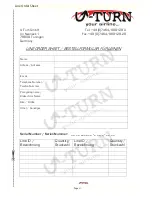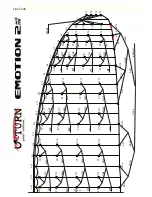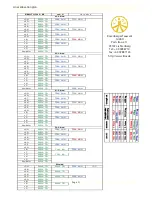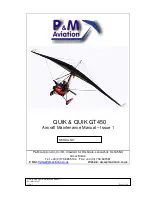
Page 14
Rapid Descent
In any situation where you have to get down ASAP for diff erent reasons (weather, extreme updraft, or
other dangers,) there are a couple of techniques that are described in this chapter.
Caution:
The described manoeuvres stress you paraglider more than normal and should only
be performed for practise or in a real emergency!
G
Spiral Dive
Like a normal turn, it is very easy to get the EMOTION 2 into a spiral dive. The spiral dive gets you a
descent rate up to 20 m/s. To prepare oneself in case of, practise it in optimum conditions. The diving
spiral gets the pilot down faster than other techniques and is therefore best suited for an emergency
descent. They move down vertically within the airmass. Don`t forget the G-forces when diving down,
and take that into consideration before initiating a rapid descent.
Caution:
If initiation is too fast there is a danger of a spin, in this case release the brake an try
a smoother initiation.
Warning:
Never fl y a spiral dive while “big earing” the glider. It is illegal aerobatics and may over
stress the both pilot and material.
G
Big Ears
Pull both on the outer A-risers one after the other (grab the line shackles) about 15-20cm to fold the
wingtips. Whilst holding the braketoggles together with the A-risers. The glider stays fully steerable and
descents with 4-7m/s straight forward. If you release the A-risers, the folded wingtips open automati-
cally. Should there be any problem with the reopening, you may pump the brakes gently.
„Big earing“ is due to the high wingload a very stable fl ight condition and well suited for turbulent air.
Be aware that you reduce the trimspeed, but that can be compensated by accelerating with your legs.
Warning:
Don`t fl y extreme manoeuvres in this confi guration, it is dangerous due to the danger
of overstressing your glider. Fullstalls and spins are dangerous for a rapid
descent because a wrong termination could have fatal consequences no matter what
glidertype you are fl ying.
ALL KINDS OF RAPID DESCENTS SHOULD BE PRACTISED IN SMOOTH AIR AND WITH
ENOUGH ALTITUDE TO BE PREPARED FOR EXTREME
SITUATIONS WHEN YOU NEED THEM
B-Stall
Another very effi
cient descent method is the B-Stall. It allows for a rate of descent of 6 to over 9 meters
per second. Check the airspace under and behind you prior to initiating a B-Stall. To initiate it you hold
the two B-risers above the lines carabiner. While you hold the brakes in your hands at all times, pull them
down progressively and symmetrically. Hold this position. Your sail will stop fl ying forward, partially
empty, and stabilize itself above your head. Exit B-stall fl ight by returning the risers symmetrically into
their original position.
We recommend not to simply let the risers snap shut as this puts a lot of pressure on the material.
In the paragraph titled “advanced handling” you can read what to do if you get caught unexpectedly
in a stall.
G
G
G







































